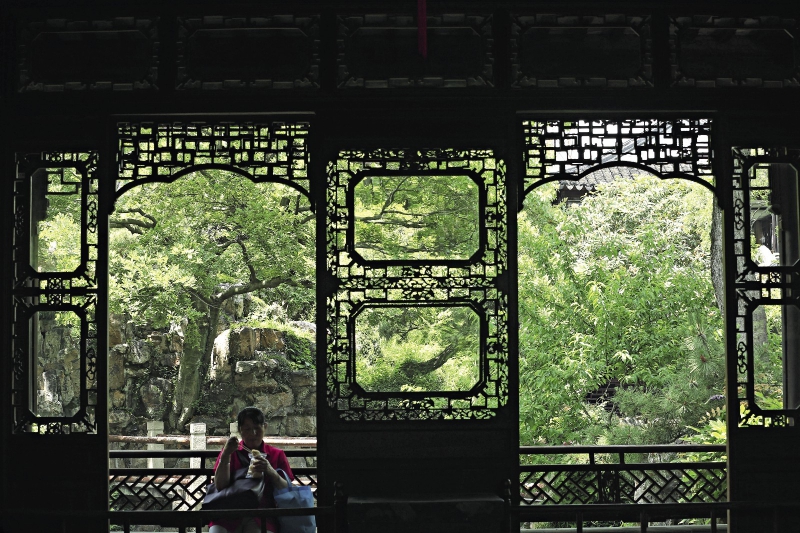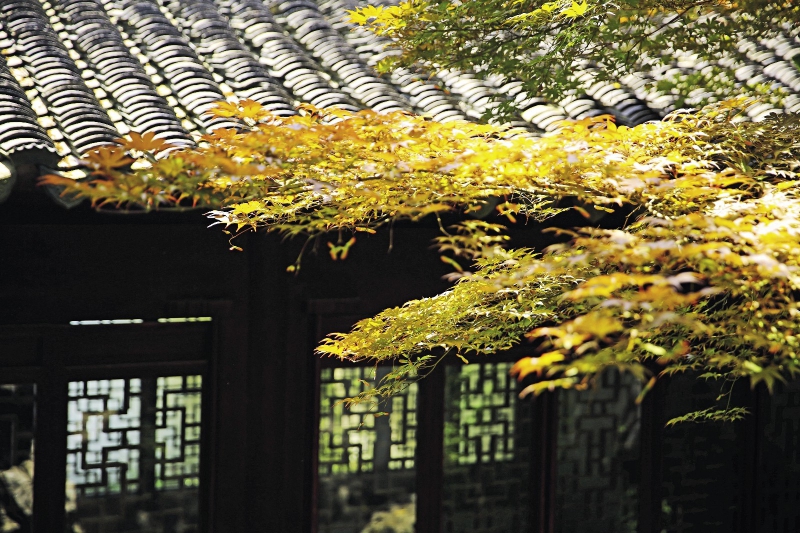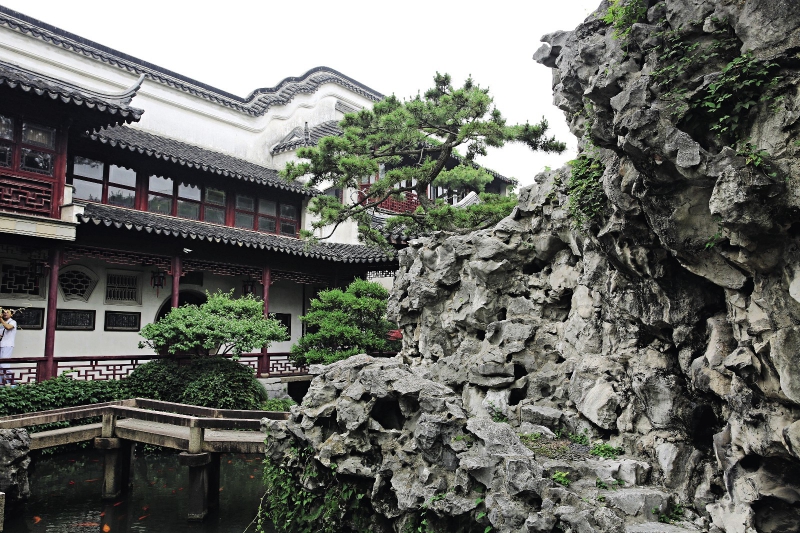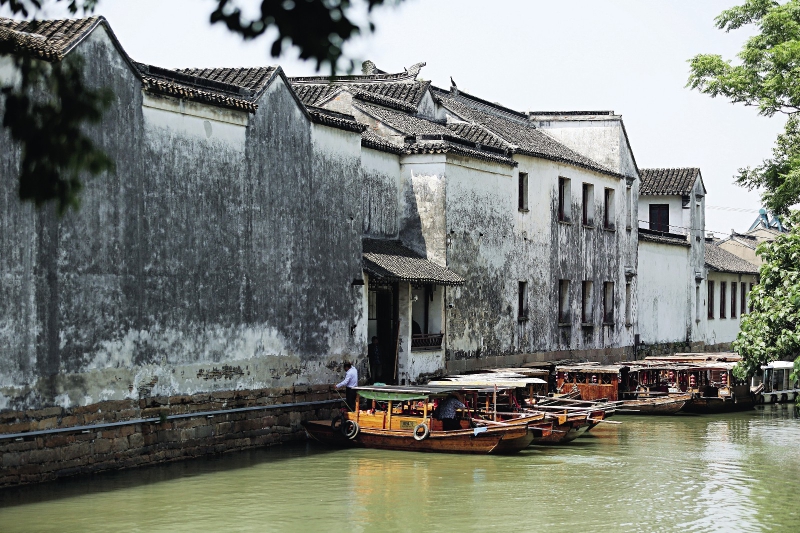SUZHOU is known, among other things, for classical gardens, each standing out for their own spontaneous beauty and representing a fragment of history. The size of each garden varies, from the bigger compounds like the Lingering Garden (Liu Yuan) and Humble Administrator’s Garden (Zhuozheng Yuan) to smaller but similarly famous ones such as the Master of Nets Garden (Wangshi Yuan). There are plenty of scenes of quiet glamor to be discovered behind the tall walls and along the narrow lanes of this time-honored city.
A corner of the Couple's Retreat Garden (Ou Yuan).
Couple’s Retreat Garden
The Couple’s Retreat Garden (Ou Yuan), as its name indicates, has the theme of love, which is palpable in every corner and every element of décor adorning this residential complex. Late in the Qing Dynasty, a scholar-turned official, Shen Bingcheng (1823-1895) and his wife Yan Yonghua, who was also well educated, bought and rebuilt this house as their love nest.
Different from other famous residences in the region, the complex consists of one living area and two gardens on either side, with all major buildings connected by a roofed corridor from east to west. In the eastern garden stands the Tinglu (meaning listening to the sound of oars) Tower, which was the place for the hostess to enjoy views of the river on the other side of the garden wall. It is nestled next to the Kui-xing (god of academic success) Tower, the study of the host. This juxtaposition signifies the equal status of the wife and husband, a novel idea in patriarchal China of old times.
A rockwork in the Mountain Villa with Embracing Beauty.
One pavilion by the pool is aptly named My Love, where Shen once told his friends he took great pleasure in watching his wife play music there. The inscription on the tablet is imbued with the affection of a devoted husband.
In this tranquil house, surrounded by rivers on three sides, the couple were shut away from worldly concerns and disturbances, and indulged themselves in calligraphy, painting, poetry, and wine. As sunlight pours in through the lavishly carved lattice of the window, the brick table, a signature furniture of old Suzhou families, is lit up, revealing the marks of brush writing on its surface, which are believed to be from the couple’s daily exchange of messages of love.
Like the two gardens, many things in the complex come in pairs, such as the two piers at the front and back gates. But in most cases they complement each other instead of replicating each other to add variety. For instance, the Caotang (hatched) House in the eastern garden parallels the Zhilian (weaving curtain) Old House in the western garden. In combination the two names signify devotion to study during days of financial stress. In the western part of the complex is a Song Dynasty (960-1279) well, while in the eastern side of the house is the Shouyue (receiving moon) Pool. The rockwork in the western garden is curvy and slender, alluding to femininity; by comparison its peer in the eastern garden is steep and sturdy, alluding to masculine toughness. The eastern rockery is said to be the work of the gardening master Zhang Nanheng (1578-1671), though some scholars think differently. Regardless, it is still a highlight of the house, and whoever designed it deserves the esteem and admiration of later generations.

Pavilion Shan-shuijian in the Couple’s Retreat Garden (Ou Yuan).
Mountain Villa with Embracing Beauty
The villa located in the Suzhou Broidery Museum is one of the nine Suzhou gardens listed as a UNESCO world cultural heritage site. Much of its reputation comes from the rockwork designed by Ge Yuliang (1764-1830), one of the two best known garden designers of the Qing Dynasty. In a modest area of 2,000 square meters, he superbly rebuilt the mountainous landscape scenes of southern China, complete with cliffs, peaks, caves, valleys, waterfalls, and brooks. Every gravel and crevice is the result of great deliberation, ensuring the rockery is quite attractive from every angle when seen from afar or up close.
Another attraction of the villa is a stone carving of the Ming Dynasty artist Tang Yin’s (1470-1524) painting Plum Blossom. Tang was a native of Suzhou and one of the most talented painter-poets in Chinese history.
The complex owes its name Embracing Beauty to the Simian (four-sided) Hall, which has large windows on all four walls. People inside looking outward in any direction are greeted by equally fascinating scenes of miniature mountains and rivers.
The river outside of Couple’s Retreat Garden (Ou Yuan).
The Garden of Cultivation
According to traditional Chinese landscaping, rockery is the skeletal structure of a garden, and water is the soul. The two supplement and reinforce each other. This principle is evident in Suzhou’s gardens. In this riverside city, landscapers paid particular attention to the amorphous resource to adapt it to the layout of individual gardens, creating big lakes or slender creeks according to the available space.
The Garden of Cultivation (Yi Pu) from the Ming Dynasty (1368-1644) is a textbook example of the artful use of water in smaller gardens. A core part and the centerpiece of the complex is a pool, lined by skillfully arranged artificial mountains. Their reflection creates an amplifying effect that makes the garden look more spacious.
North of the pools lie the main buildings of the complex, and on the south are two mini courtyards conjoined to the artificial mountains. Looking down from the pavilion atop the mountains, people can see the merit of its simplistic design: scenes of unadorned, uninterrupted beauty.
The Garden of Cultivation has changed hands and names multiple times over its long history of over 400 years. Its best-known owners are the Wen brothers. Wen Zhenmeng (1574-1636), an official and calligrapher, bought this house, and planted medicinal herbs there out of the hope of staying away from court politics and cultivating both mind and body. His younger brother Wen Zhenheng wrote a book on landscaping and managed this property after Zhenmeng died.
The Ruyu (feeding fish) Pavilion is the only one of its kind dating back to the Ming Dynasty in Suzhou. Its wood structure is plainly distinct from other pavilions in the region, and a dragon is a repeated motif on the beams, architraves, bracket sets, and ceiling. It is said that fish in the adjacent pool gathered every morning and evening to pay tribute to the dragon king. Spectators thought they were waiting to be fed, hence the pavilion got its name.
All the owners of the Garden of Cultivation were accomplished scholars of high aspirations, as were expressed in the couplets and tablets they left behind in the garden. One thing worth noticing is that these inscriptions often imply resentment against the Qing rulers and yearnings for restoring the Ming regime, a feeling common among Han literati at the time.
Yanguang (stretching light) Pavilion is the largest riverside pavilion in Suzhou. Long and narrow, it resembles a roofed corridor enveloping a pool. To set off the open water space, a reclusive mini courtyard Yu’ou (bathing fowls) was built on the bank. Contrast but conformity, this is at the heart of the design of Suzhou gardens.
_______________
ZHAO YANQING is a columnist.



